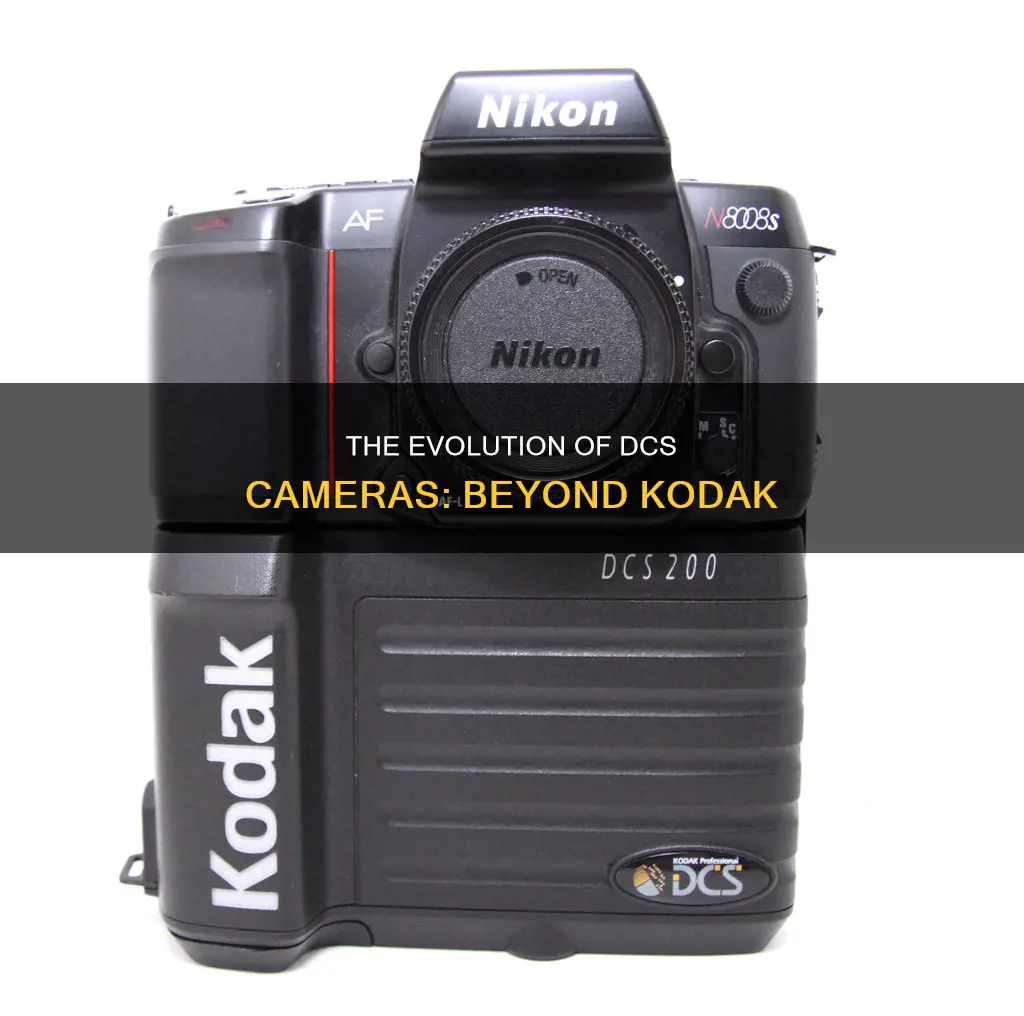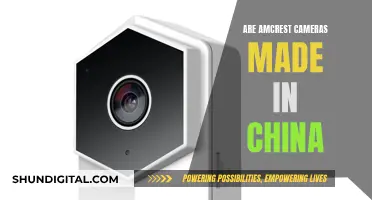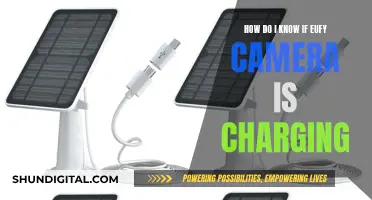
The Kodak Professional Digital Camera System, or DCS, was the first commercially available digital single-lens reflex (DSLR) camera. It was released in May 1991 and was based on a Nikon F3 body. The DCS was developed by Kodak's Professional Photography Division (PPD) and marketed towards news reporters and journalists. The camera consisted of an unmodified F3 camera body attached to a custom-made winder and a digital back, with a separate digital storage unit (DSU) for storing and visualising images. While Kodak continued to release new DCS models over the years, the brand eventually discontinued its DCS range in 2005 to focus on compact digital cameras and high-end medium format digital backs.
| Characteristics | Values |
|---|---|
| Prototype | First prototype digital still camera developed in 1975 by Steven Sasson |
| Resolution | 100 x 100 pixels |
| Sensor | Fairchild 100 x 100-pixel CCD |
| Storage | Cassette tape |
| First Commercially Available DSLR Camera | Kodak DCS, later unofficially named DCS 100 |
| Launch Date | May 1991 |
| Resolution | 1.3 megapixels |
| Storage | Digital Storage Unit (DSU) |
| Price | $20,000 |
| Units Sold | 987 |
What You'll Learn

The Kodak DCS was the first commercially available DSLR camera
The Kodak DCS, later renamed the DCS 100, was the first commercially available DSLR camera. It was released in May 1991 and retailed for around $20,000 to $30,000. The camera was a collaboration between Kodak and Nikon, with a digital imaging system built around a Nikon F3 SLR camera body.
The DCS was the result of years of research and development by Kodak, building on a prototype digital camera invented by Kodak engineer Steven Sasson in 1975. This prototype was the first-ever digital still camera and used a Fairchild CCD electronic sensor. By 1986, Kodak had developed a sensor with 1.4 million pixels, which was used in the world's first Digital Single-Lens Reflex (D-SLR) camera, known as the Electro-Optic Camera.
The DCS 100 retained many of the characteristics of the prototype, including a separate shoulder-mounted Digital Storage Unit (DSU) for storing and visualising images, and housing batteries. The DSU included an LCD screen, an internal hard drive, and a standard SCSI interface for transferring files to a computer. The camera had a resolution of 1.3 megapixels and was aimed at the photojournalism market, offering faster transmission of photographs back to the studio or newsroom.
The Kodak DCS was followed by the DCS 200 in 1992, which was designed to complement the original model and target the lower end of the professional photography market. The DCS 200 integrated all essential components into a permanently attached digital back, doing away with the separate DSU. This made the camera more portable and flexible, and it retailed for exactly half the price of the DCS 100 at $9,995.
Camera Battery Explosions: How Common Are They?
You may want to see also

The DCS was developed from a prototype by Steven Sasson
The first digital camera was developed by Steven Sasson, an American electrical engineer, in 1975. Sasson, who joined Kodak shortly after graduating from engineering school, was tasked with finding a practical use for the recently created charged coupled device (CCD).
Sasson's prototype digital camera was developed at Kodak and used a Fairchild 100 x 100-pixel CCD. The camera was the size of a printer and weighed around 3.6 kg. It captured black-and-white images on a digital cassette tape, and took 23 seconds to capture each image.
Sasson's prototype was not the first camera to produce digital images, but it was the first handheld digital camera. The camera was also unique in that it had no moving parts and was entirely self-contained.
In 1977, Kodak filed a patent application for some features of Sasson's prototype, listing Sasson and Gareth Lloyd as co-inventors. This patent claimed an arrangement that allowed the CCD to be read out quickly and written to storage at a lower speed. This arrangement is still used in most modern digital cameras.
Kodak's first commercially available digital camera, the Kodak Professional Digital Camera System (DCS) or DCS 100, was released in 1991. It was based on a Nikon F3 body and had a resolution of 1.3 megapixels. The DCS 100 was aimed at the photojournalism market and retailed for $20,000.
The DCS 100 was followed by several other models in the DCS series, including the DCS 200 in 1992, the DCS 400 series in 1994, and the DCS 500 series in 1998. These cameras offered improved features such as integrated LCD screens, removable batteries, and higher resolutions.
Despite Kodak's early lead in digital camera technology, the company was slow to adopt digital photography and eventually lost its dominant position in the camera market. In 2012, Kodak filed for bankruptcy.
Mastering Camera Raw White Balance
You may want to see also

The DCS was based on the Nikon F3 body
The Kodak DCS, or Digital Camera System, was a series of digital single-lens reflex cameras released by Kodak from the 1990s to the early 2000s. The original Kodak DCS, later unofficially called the DCS 100, was the first commercially available DSLR camera. It was first launched in May 1991 and was based on a Nikon F3 body.
The Nikon F3 was a popular choice for Kodak's first commercial digital camera. The F3 was Nikon's third professional single-lens reflex (SLR) camera and was the most widely used professional camera at the time. This meant that the DCS would be familiar to many professional photographers, making the transition from film to digital easier. Additionally, the F3's motor drive contacts provided signals sufficient for electronic synchronisation.
The DCS consisted of an unmodified F3 camera body attached to a custom-made winder and a digital back. The digital back contained a 1.3-megapixel digital image sensor, which was smaller than the full 35mm film frame. To address this, Kodak added coloured templates to the viewfinder to indicate the area the sensor would capture. Captured photos were stored on a separate digital storage unit (DSU) that connected to the camera winder via an interconnect cable.
The DCS was aimed at the photojournalism market, with the goal of improving the speed of transmitting photographs back to the studio or newsroom. The DSU included an LCD screen for reviewing images, an internal hard drive for storage, and a standard SCSI interface for transferring files to a compatible computer. Despite its innovations, the DCS had limitations, such as a bulky design and poor buffer performance, which affected its high-speed shooting capabilities.
Kodak followed up the DCS with the DCS 200 in 1992, which was based on the lower-weight Nikon 8008s body. This model integrated all essential components into a permanently attached digital back, doing away with the separate DSU.
Understanding Vibrance Slider: Enhancing Your Photos in Camera Raw
You may want to see also

The DCS was aimed at photojournalists
The Kodak Professional Digital Camera System, or DCS, was the first commercially available digital single-lens reflex (DSLR) camera. It was released by Kodak in May 1991, and was aimed at photojournalists.
The DCS was a customized camera back bearing a digital image sensor, mounted on a Nikon F3 body. The camera was designed to improve the speed with which photographs could be transmitted back to the studio or newsroom. The DCS had a resolution of 1.3 megapixels and was priced at $20,000.
The DCS was the result of years of development by Kodak, which began in 1975 when Steven Sasson developed the company's first prototype digital still camera. By the early 1980s, Kodak had created a functioning CCD imaging system that rendered images at one million pixels. However, the company kept its digital camera research under wraps for most of the decade, as sales of compact film cameras were strong and they didn't want to cannibalize their own sales.
In the late 1980s, Kodak began presenting prototypes of digital cameras to US government clients, including the military, who expressed serious interest in the technology for espionage and covert operations. These prototypes were the first truly portable digital cameras, built using modified Canon F-1 bodies hooked up to a large external hard drive.
The DCS was based on the Nikon F3 SLR film camera, which was chosen because it was the most widely used professional camera at the time. By taking out the film chamber and replacing it with a 1.3-megapixel digital sensor, Kodak created a digital imaging solution that was familiar to photojournalists and made the transition from film to digital easier.
To make the camera more portable, Kodak included a separate Digital Storage Unit (DSU) that could be worn on the shoulder. The DSU included an LCD screen for reviewing images, an internal hard drive for storage, and a standard SCSI interface for transferring files to a computer. Despite these innovations, the DCS was still bulky and heavy, weighing several dozen pounds.
The DCS sold modestly, with about 1,000 units sold in North America over three years. The camera's high price tag of $20,000 was a limiting factor for many potential customers. However, it was still considered a success for an innovative trailblazer based on prototype technology.
Keystone Movie Cameras: How Many Were Manufactured?
You may want to see also

The DCS was sold between 1991 and 1994
The Kodak Professional Digital Camera System, or DCS, was the first commercially available digital single-lens reflex (DSLR) camera. It was launched in May 1991 and sold until 1994. The DCS was a customised camera back bearing a digital image sensor, mounted on a Nikon F3 body. The camera was aimed at the photojournalism market, with the goal of improving the speed of transmitting photographs back to the studio or newsroom.
The DCS had a resolution of 1.3 megapixels and was presented publicly for the first time in Arles, France, by the worldwide president of the Eastman Kodak Company, Mr Ray H. DeMoulin. The camera was priced at $20,000 and a total of 987 units were sold between 1991 and 1994.
The DCS was the result of years of research and development by Kodak, building on their previous work with digital camera prototypes. The Nikon F3 was chosen as the base for the DCS because it was the most widely used professional camera at the time, allowing Kodak to preserve the familiar feel and look of a professional SLR camera.
The DCS included a Digital Storage Unit (DSU) that was carried on the shoulder and housed the batteries, hard drive, and LCD screen for reviewing images. The DSU also allowed for the addition of an external keyboard for editing and processing images in the field.
The original DCS was followed by the DCS 200 in 1992, which was designed to complement the original model and target the lower end of the professional photography market. The DCS 200 integrated all essential components into a permanently attached digital back, doing away with the separate DSU of the original model.
Y Dome Camera: Battery-Powered Security Solution?
You may want to see also
Frequently asked questions
The Kodak Professional Digital Camera System, later unofficially named the DCS 100, was the first commercially available digital single-lens reflex (DSLR) camera.
The DCS 100 had a resolution of 1.3 megapixels.
The DCS 100 was released in May 1991.







